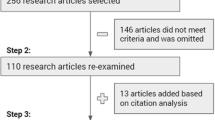Abstract
Product lifecycle management (PLM) is a new business strategy for enterprise’s product R&D. A PLM system holds and maintaining the integrity of the product data produced throughout its entire lifecycle. There is, therefore, a need to build a safe and effective product data model to support PLM system. The paper proposes a domain-based product data model for PLM. The domain modeling method is introduced, including the domain concept and its defining standard along the product evolution process. The product data model in every domain is explained, and the mapping rules among these models are discussed. Mapped successively among these models, product data can be successfully realized the dynamic evolution and the historical traceability in PLM system.
Similar content being viewed by others
References
Sudarsan R, Fenves SJ, Sriram RD, Wang F (2005) A product information modeling framework for product lifecycle management. Comput-Aided Des 37(13):1399–1411
Xiaoqing T, Yun Hu (2008) Data model for quality in product lifecycle. Comput Ind 59(2–3):167–179
Bellatreche L, Dung NX, Pierra G, Hondjack D (2006) Contribution of ontology-based data modeling to automatic integration of electronic catalogues within engineering databases. Comput Ind 57(8–9):711–724
Peng TK, Trappey Amy JC (1998) A step toward STEP-compatible engineering data management: the data models of product structure and engineering changes. Robot Comput-Integr Manuf 14(2):89–109
Giannini F, Monti M, Biondi D, Monari PD (2002) A modeling tool for the management of product data in a co-design environment. Comput-Aided Des 34(14):1063–1073
Gang Z, Guofu Y, Kewen D (2005) Research on assembly-oriented characteristics-hierarchy modeling method. Comput Integr Manuf Syst 11(7):916–920
Lee G, Sacks R, Eastman C (2007) Product data modeling using GTPPM—a case study. Autom Constr 16(3):392–407
Brière-Côté A, Rivest L, Desrochers A (2010) Adaptive generic product structure modeling for design reuse in engineering-to-order products. Comput Ind 61(1):53–65
Liang C, Guodong J (2006) Product modeling for multidisciplinary collaborative design. Int J Adv Manuf Technol 30(7–8):589–600
Nakatani LH, Ardis MA, Olsen RG, Pontrelli PM (1999) Jargons for domain engineering. In: Proceedings of the 2nd Conference on Domain-Specific Languages, pp 15–24
Addy EA (1998) A framework for performing verification and validation in reuse based software engineering. Ann Software Eng 5(1):279–292
Kang KC, Kim S, Lee J, Kim K, Shin E, Huh M (1998) FORM: A feature-oriented reuse method with domain-specific reference architectures. Ann Software Eng 5(1):143–168
Prieto-Diaz R, Arango G (1990) Domain analysis and software systems modeling. IEEE Computer Society, Silver Spring, pp 9–52
Leung KRPH, Leung HKN, Suk F (1999) A COTS selection method using domain model, TR-20, Department of Computing, Hong Kong Polytechnic University
Nordstrom G, Sztipanovits J, Karsai G, Ledeczi A (1999) Metamodeling- rapid design and evolution of domain-specific modeling environments. In: Proceedings of the IEEE Sixth Symposium on Engineering Computer-Based Systems (ECBS), pp 68–74
Reinhartz-Berger I, Sturm A (2007) Enhancing UML models: a domain analysis approach. J Database Manag JDM 19(1):74–94
Mernik M, Heering J, Sloane AM (2005) When and how to develop domain-specific languages. ACM Comput Surv 37(4):316–344
Tan Tongde, Tong Bingshu, Wang Tao (2000) The data model for product structure design [J]. Journal of Computer-Aided Design & Computer Graphics, 2000, 12(1):11–16
Author information
Authors and Affiliations
Corresponding author
Rights and permissions
About this article
Cite this article
Li, Y., Wan, L. & Xiong, T. Product data model for PLM system. Int J Adv Manuf Technol 55, 1149–1158 (2011). https://doi.org/10.1007/s00170-010-3130-4
Received:
Accepted:
Published:
Issue Date:
DOI: https://doi.org/10.1007/s00170-010-3130-4




